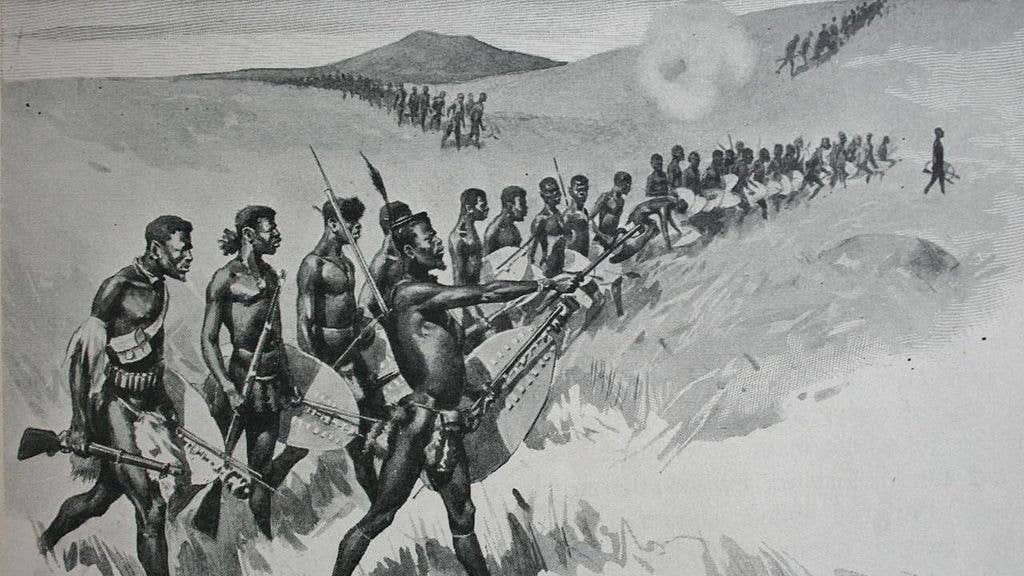The indomitable spirit of the Zulu Warriors

Zulu regiment attacking at Isandlwana. Wikimedia Commons.
SUMMARY
Hold onto your pith helmets, folks, we're journeying into the heart of the Zulu Kingdom at the brink of the Anglo-Zulu War. This isn't the opening of another swashbuckling adventure film, but it probably should be. Instead, it's late 1878 and relations between the British Empire and the Zulu Kingdom are as tense as a drum skin. A seemingly minor border dispute lit the fire. But the truth is, the kindling had been set long before. In fact, the British Ultimatum of December 1878 set a course for war. It demanded something King Cetshwayo couldn't possibly concede – a surrender of Zulu sovereignty.
Storming Isandlwana
It's January 22, 1879. The air in the British camp at Isandlwana is thick with the anticipation of a coming battle. They've heard rumblings that there's a formidable Zulu force nearby, but they're not worried. After all, they have Martini-Henry rifles and a rock-solid belief in their invincibility. Their assembled force of 1,800, they reckon, is more than a match for the 'primitive' Zulu.
What a mistake.
As the day creeps on, the unthinkable happens. Nearly 20,000 Zulu warriors, equipped with their iconic oval shields and short stabbing spears, known as the iklwa, appear like a storm on the horizon. Outnumbered nearly ten to one, the British are caught flat-footed. So much for those fancy rifles. They scramble to form a defensive line, but it's too little, too late. The Zulu attack, as relentless as the African sun and as fierce as a cornered lion, descends upon the British. When the dust finally settles, the landscape is a grim testament to Zulu might and the hubris of the British. All that's left is a smoldering ruin, littered with the fallen.
The Zulu's tactical genius
It's important to understand the Zulu are not just warriors. They're also shrewd tacticians who've honed their battle strategies over generations. Their famous 'horns of the buffalo' formation is a masterstroke of military planning, designed to both intimidate and decimate their enemies.
Imagine you're a British soldier standing on the battlefield. In front of you, the 'chest' of the Zulu force charges, their aim to pin you down and engage your main force. But don't get too focused on them. To your left and right, the 'horns' – swift, elite warriors – are circling around. Their primary objective is to flank and encircle your formation. Rounding it all out are the 'loins', reserves standing at the ready. These dudes aren't just the balcony audience. No. THey're preparing to surge forward and exploit any weaknesses in your ranks when it's going to hurt the most.
And all of this is happening with a speed and synchronicity that leaves your head spinning. The British quickly realize these aren't haphazard charges or random skirmishes. These are carefully orchestrated maneuvers that use the sheer number of warriors and their intimidating presence to devastating effect.
Siege of Rorke's Drift
As if the defeat weren't humiliating enough, we're moving on to the Battle of Rorke's Drift. Despite their defeat at Isandlwana, the British decided they'd give it one more go. So, a small garrison of 150 men at Rorke's Drift found themselves facing an army of 3,000-4,000 Zulu warriors. Apparently no one ran the numbers and someone up the flagpole thought this was a good idea. The truth is, it was a terrifying night of desperate defense. Remarkably, when the smoke cleared, the tiny garrison had held out. This battle was a turning point in the war, where British resilience would eventually lead to a shift in momentum.
Battle of Ulundi
Like any epic tale, our story draws to a climactic end with another fierce battle. The Battle of Ulundi was fought in July 1879. Vast swathes of Zulu warriors gathered to prepare for one last, magnificent stand. They were there not just to defend their land and their freedom, but also their way of life. And let's be for real. They'd proven themselves against the formidable British, so confidence was definitely high.
But no one underestimates the British, even in the face of defeat. By the time July 1879 rolls around, the Brits have licked their words and regrouped. They're ready to come back with a vengeance. This time they aren't complacent since they've seen what Zulu warriors can do so they vow to bring it. Without much preamble, the Zulu find themselves up against a square formation of red-coated soldiers, bristling with lethal Martini-Henry rifles.
With no regard for life, the Zulu warriors charge forward with the spirit of their ancestors. The British, entrenched in their formation, hold firm. Volley after volley of bullets tears into the Zulu ranks. It becomes evident, rather quickly, that their shields and spears are no match for the British firepower. The Zulu charge again, crashing against the British square, but fails to break it.
Unfortunately, the fall of Ulundi signals the tragic end of the Zulu Kingdom's resistance. The British finally claim victory - at a terrible cost.
Unbreakable spirit of the Zulu
The Zulu may have been undone by the British Empire's overwhelming resources and firepower, but they left their mark, a blazing trail of resilience and tactical genius. They painted a stark picture of the harsh cost of underestimating your opponent and reminded the world that a well-executed strategy, courage, and unity are formidable adversaries on any battlefield. In the annals of warfare, they stand tall, a beacon of inspiration, teaching us that in the face of overwhelming odds, with unity, strategy, and an indomitable spirit, even the 'smallest' can stand up to the giants.
SHARE
